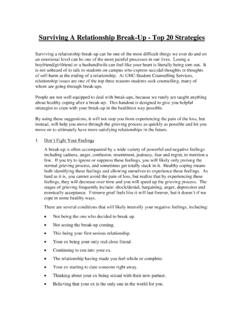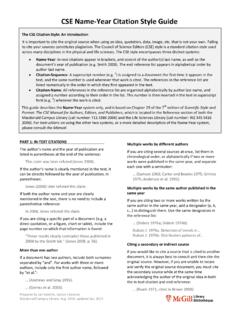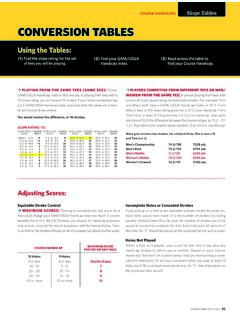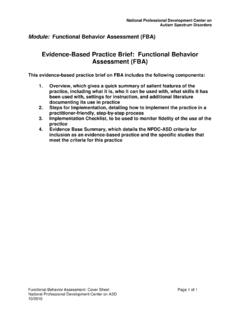Transcription of Professional competencies - McGill University
1 Core Professional competencies for the teaching profession55 Professional competencies1. To act as a Professional inheritor, critic and inter-preter of knowledge or culture when To communicate clearly in the language ofinstruction, both orally and in writing, using cor-rect grammar, in various contexts related To adapt his or her teaching to the needs and char-acteristics of students with learning disabilities,social maladjustments or To integrate information and communications tech-nologies (ICT) in the preparation and delivery ofteaching/learning activities and for instructionalmanagement and Professional development To cooperate with school staff, parents, partners inthe community and students in pursuing the edu-cational objectives of the To cooperate with members of the teaching team incarrying out tasks involving the development andevaluation of the competencies targeted in the pro-grams of study, taking into account the and educational context3.
2 To develop teaching/learning situations that are appro-priate to the students concerned and the subject contentwith a view to developing the competencies targeted inthe programs of To pilot teaching/learning situations that are appropriateto the students concerned and to the subject contentwith a view to developing the competencies targeted inthe programs of To evaluate student progress in learning the subjectcontent and mastering the related To plan, organize and supervise a class in such a way asto promote students' learning and social act11. To engage in Professional development indi-vidually and with To demonstrate ethical and responsible pro-fessional behaviour in the performance of hisor her identitySummary table123To act as a Professional inheritor, critic and interpreter ofknowledge or culture when teaching No1By the end of his or her initial training, the studentteacher should be able to :4understand the subject-specific and program-specific knowledge to be taught, so as to beable to promote the creation of meaningfullinks by the students;4exhibit a critical understanding of his or hercultural development and be aware of itspotential and limitations;4exhibit a critical understanding of the knowl-edge to be taught, so as to promote the cre-ation of meaningful links by the students.
3 4 Establish links with the students' culture in theproposed learning OF MASTERY4 Situates the discipline's basic benchmarks andpoints of understanding (concepts, postulatesand methods) in order to facilitate significant, in-depth learning by a critical approach to the subject links between the secondary cultureset out in the program and the secondary cultureof the the classroom into a cultural baseopen to a range of different viewpoints within acommon a critical look at his or her own origins,cultural practices and social table125To communicate clearly in the language of instruction,both orally and in writing, using correct grammar, in var-ious contexts related to No2 LEVEL OF MASTERY4 Uses appropriate language when speaking tostudents, parents and rules of grammar and stylisticswhen writing texts intended for students, par-ents or able to take up a position, support his orher ideas and argue his or her subject matterin a consistent, effective.
4 Constructive andrespectful way during ideas concisely using precisevocabulary and correct the mistakes students make whenspeaking and strives to improve his or her ownoral and written language the end of his or her initial training, the studentteacher should be able to :4master the rules of oral and written expression soas to be understood by most of the linguisticcommunity;4 Express himself or herself with the ease, preci-sion, efficiency and accuracy expected by societyof a teaching table127To develop teaching/learning situations that are appropriate tothe students concerned and the subject content with a view todeveloping the competencies targeted in the programs No3By the end of his or her initial training, the studentteacher should be able to :4develop appropriate and varied teaching/learn-ing situations involving a reasonable level ofcomplexity that enable students to progress inthe development of their competencies .
5 4 Build these activities into a long-term OF MASTERY4 Bases the selection and content of teachingsequences on data drawn from recent didacticaland pedagogical and interprets subject-specific knowledgein terms of the aims, competencies and subjectcontent specified in the program of teaching and evaluation sequences takinginto account the logic of the content to the taughtand the development of into account the prerequisites, conceptions,social differences ( gender, ethnic origin, socio-economic and cultural differences), needs andspecial interests of the students when developingteaching/learning diverse instructional approaches that aresuited to the development of the competenciestargeted in the programs of obstacles to learning posed by thecontent to be learning situations that provide opportuni-ties to apply competencies in different table129To pilot teaching/learning situations that are appropriate tothe students concerned and to the subject content with a viewto developing the competencies targeted in the programs No4By the end of his or her initial training, the studentteacher should be able to :4guide students, through appropriate interventions, incarrying out learning tasks;4lead the students to work together in cooperation.
6 4 Detect teaching/learning problems that arise and usethe appropriate resources to remedy OF MASTERY4 Creates conditions in which students canengage in meaningful problem situations, tasksor projects, based on their cognitive, emotionaland social students with the resources they needto take part in the learning students in selecting, interpreting andunderstanding the information provided in thevarious resources and in understanding the ele-ments of a problem situation or the require-ments of a task or student learning by asking questionsand providing frequent and relevant feedback topromote the integration and transfer of table131To evaluate student progress in learning the subjectcontent and mastering the related No5By the end of his or her initial training, the studentteacher should be able to :4detect the strengths and weaknesses of the stu-dents in a learning situation;4identify some of the adjustments required in his orher teaching on his or her own;4in cooperation with colleagues, design evaluationmaterials, interpret the work of students in termsof their mastery of the competencies , and developtools for communicating with parents.
7 4 Inform the students of the results of a diagnosticevaluation process and inform parents and mem-bers of the teaching team of the corrective inter-vention strategy elements OF MASTERY4 Gathers information as students are engaged in alearning situation in order to identify their strengthsand weaknesses and to review and adapt his or herteaching accordingly to help them stock of the learning acquired by students inorder to assess their mastery of the related or uses tools to evaluate student progressand mastery of expected outcomes to students andparents and provides feedback on student progressand mastery of competencies using clear, simple with the teaching team to determine thedesired stages and rate of progression within the table133To plan, organize and supervise a class in such a way as topromote students' learning and social No6By the end of his or her initial training, the studentteacher should be able to :4introduce and maintain routines that ensure thesmooth running of regular classroom activities;4identify and correct organizational problems thathinder the smooth running of the class;4anticipate some of the organizational problemsthat hinder the smooth running of the class andplan measures to prevent them.
8 4 Establish and apply methods that can be used tosolve problems with students who exhibit inap-propriate OF MASTERY4 Develops and implements an efficient system forrunning regular classroom clear requirements regardingappropriate school and social behaviour andmakes sure that students meet those students on an individual or a groupbasis in setting standards for the smooth runningof the strategies for preventing inappropriatebehaviour and dealing effectively with it when a classroom climate that is conduciveto table135To adapt his or her teaching to the needs and characteristicsof students with learning disabilities, social maladjustments No7By the end of his or her initial training, the studentteacher should be able to :4 Cooperate in the development and implementationof individualized education plans designed for stu-dents under his or her OF MASTERY4 Facilitates the educational and social integrationof students with learning disabilities, social mal-adjustments or resource people and parents to obtainbackground information on students with difficul-ties (needs, progress, etc.)
9 4 Proposes learning tasks, challenges and roleswithin the class that help students to in developing and implementing indi-vidualized education table137To integrate information and communications technologies(ICT) in the preparation and delivery of teaching/learningactivities and for instructional management and profession-al development No8By the end of his or her initial training, the stu-dent teacher should be able to :4demonstrate critical judgment regarding thereal benefits and limitations of ICT as teachingand learning resources;4demonstrate a general understanding of the possi-bilities offered by ICT (and the Internet in particular)for teaching and learning, and know how to inte-grate ICT in a functional manner into teaching/learn-ing activities, when appropriate;4use ICT effectively in different aspects of his or herintellectual and Professional life: communication,research, information processing, evaluation, inter-action with colleagues or experts, etc.
10 ;4 Effectively transmit the ability to use ICT to his or herstudents in order to support the collective construc-tion of learning in a well-structured, critical OF MASTERY4 Exercises critical judgment regarding the realbenefits and limitations of ICT as teaching andlearning resources, and regarding the socialissues they the instructional potential of computerapplications and networking technology in rela-tion to the development of the competencies tar-geted in the programs of using various multimedia ICT effectively to search for, interpret andcommunicate information and to solve ICT effectively to build networks that facili-tate information sharing and Professional devel-opment with respect to his or her own field ofteaching or teaching students to familiarize themselves with ICT,to use ICT to carry out learning activities, toassess their own use of ICT, and to exercise criti-cal judgment regarding the information they findon the table139To cooperate with school staff, parents, partners in the com-munity and students in pursuing the educational objectives ofthe No9By the end of his or her initial training, the studentteacher should be able to :4situate his or her role in relation to that played byother internal or external resource persons;4adjust his or her actions to the educational objec-tives of the school and contribute to the attainmentof these objectives by becoming personallyinvolved in school projects.


















